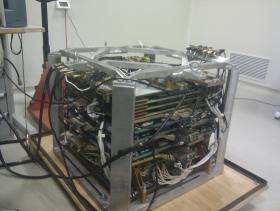Scientific equipment "NUCLEON" developed by SINP scientists passes electrodiagnostical tests as a part of the satellite "Resurs-P" N2. The purpose of the tests is to confirm equipment's operating capability and availability according with the target purpose. The tests are organized in the TsSKB "Progress" (Samara, Russia).
Scientific equipment "NUCLEON" (fromed from the word "nucleon" - a part of the nucleus) is intended for the studies of the Galaxy, its objects, antimatter, dark and strange matter by means of detection and analyzing of galactic cosmic rays. It is an intensive flux of hadron component: from the protons up to the heaviest nuclei from the Element Periodic Table, and insignificant flux of electrons and positrons.
Senior scientist of the Department of space radiation, PhD. Andrey Turundaevsky told us about the ways for the studies of the Galaxy by means of cosmic rays studies:
"In contrary to the photons charged particles of the cosmic rays are diverged by the galactic magnetic fields and move along complicated curved trajectories depending on their charge and energy. However there are possible interactions with interstellar gas which lead to fragmentation of heavy nuclei and generation of new particles including antiprotons. So spectrum and composition of cosmic rays reflect as properties of the sources as properties of interstellar medium. Comparing the results of different scientific simulations it is possible to make conclusions about the characteristics of supernovae explosions which generate shock waves, about supercondensed objects such as black holes and magnetars, about the structure of the Galaxy as a whole. New ideas are developed in order to explain the observed phenomena, for instance hypernovae hypothesis. Studies of the antiprotons and search for antinuclei in cosmic rays are continued. If antiprotons can be generated during nonelastic high-energy hadron interactions, existence of antinuclei could indicate existence of more or less significant population of antimatter. It could explain the puzzle of barion asymmetry of the Universe. Besides, the problem of dark matter still remains. It is only proved that it exists, because a number of models is based on existance of its exotic particles (WIMP) which are able to interact producing electrons and gammas. Such particles should prove themselves in electrons and gammas spectra. Strange matter (stable nuclei with abnormal charge-mass ratio) can prove itself during the orbital measurements of the "NUCLEON" calorimeter, if hadron cascade can be detected."
Scientific equipment "NUCLEON" is manufactured as a monoblock with overall dimensions less than 1 meter and weight of 300 kg. As far as "NUCLEON" is light, it is planned to place it as an additional payload onboard the serial satellite for the Earth remote sensing "Resurs-P" N2. "NUCLEON" equipment will be fixed to the satellite by a connecting rod. Power supply and control will be also provided by the satellite. Power capacity is 160 W. Scientific and service information traffic is about 8-10 GBytes/day. Inspite of its small size "NUCLEON" instrument includes about 12 thousands of sensors. Unlike the satellite the scientific equipment will be pointed at space, not at the Earth. Warranty lifetime of "NUCLEON" is not less than 5 years.
"The purposes of electrodiagnostical tests of "NUCLEON" are to confirm the accuracy of electric connections between the scientific equipment and satellite's systems and function tests of the basic and duplicate half-sets of internal subsystems and their inter-block connections", - electronic of the Department of space radiation Oleg Vasiliev told us.
He also told us, that all tests of the "NUCLEON" equipment as part of the satellite are carried out by means of automated test complex based on the control computer and testing software. The "NUCLEON" is connected with the satellite's systems by means of flight mate.
Preliminary it is planned to launch the satellite "Resurs-P" N2 with the scientific equipment "NUCLEON" onboard this year (2014).

